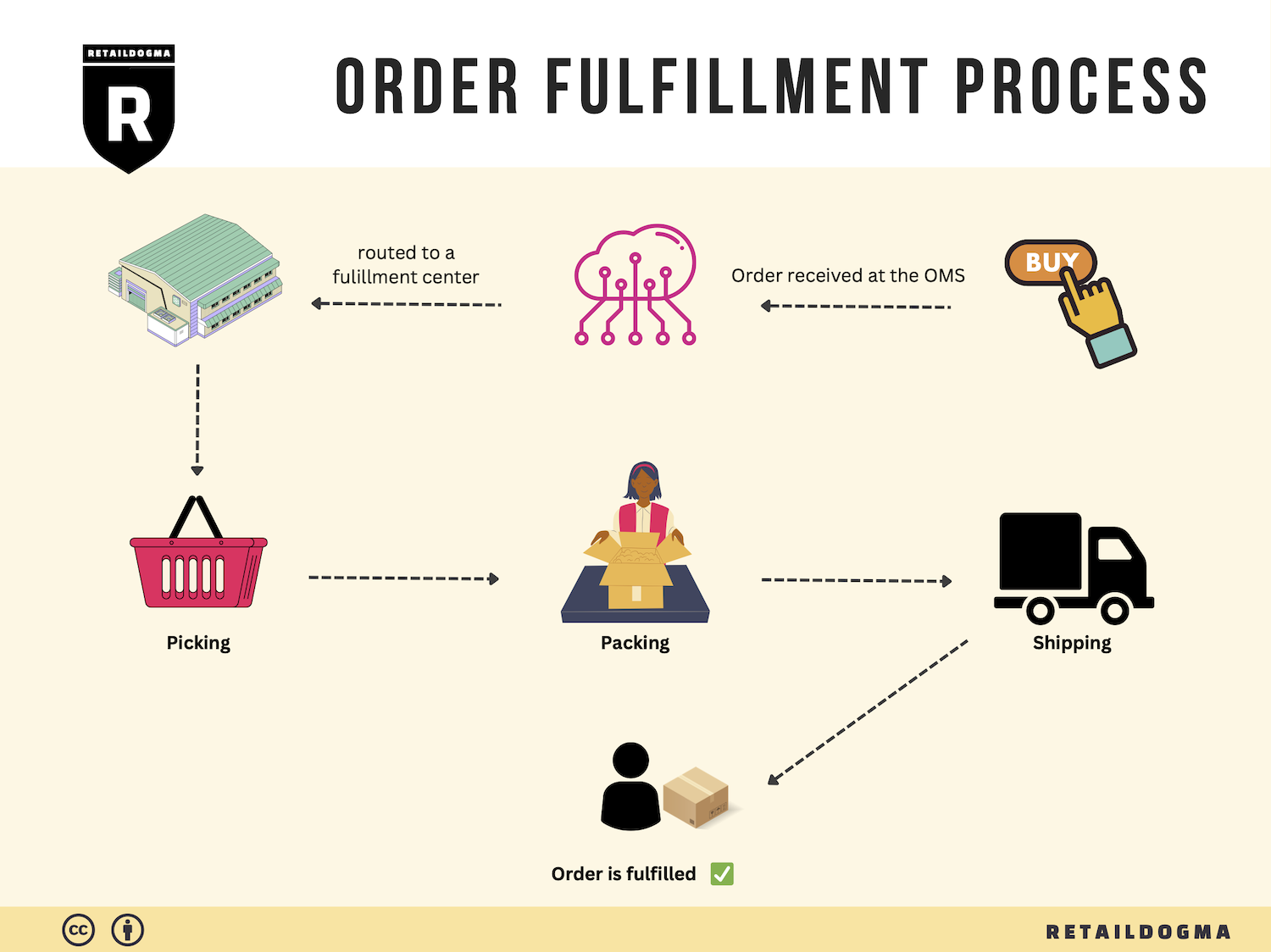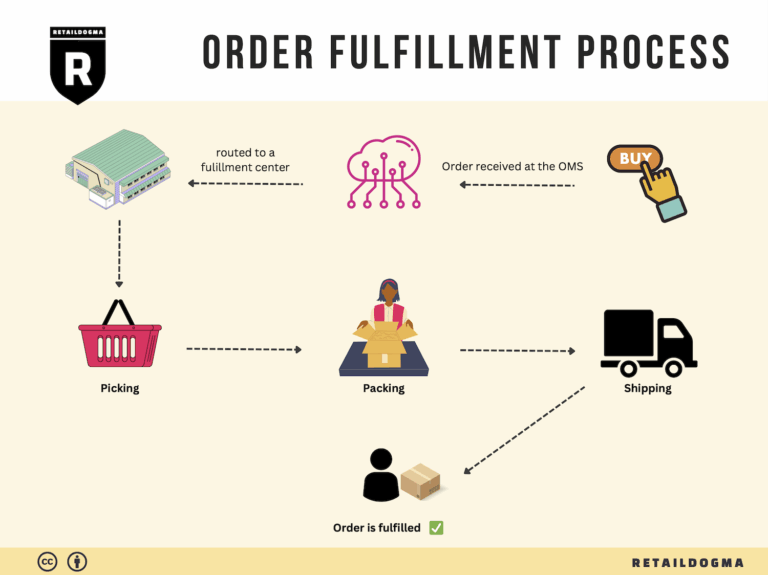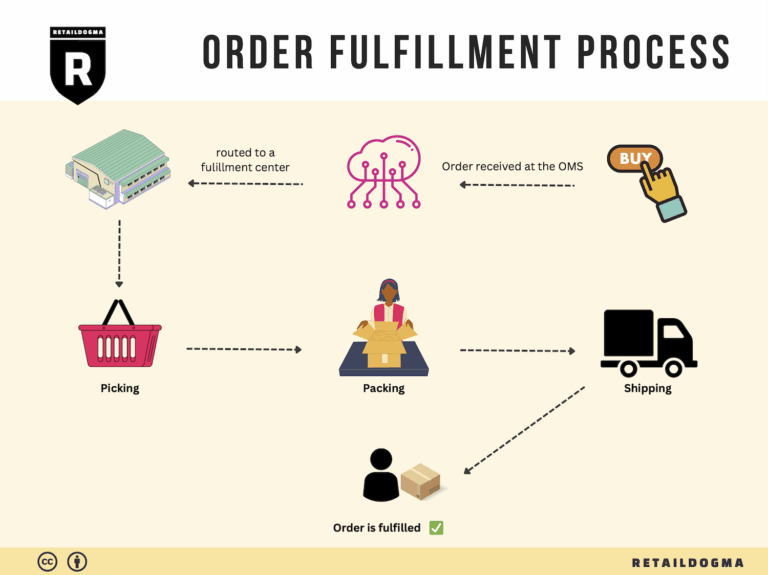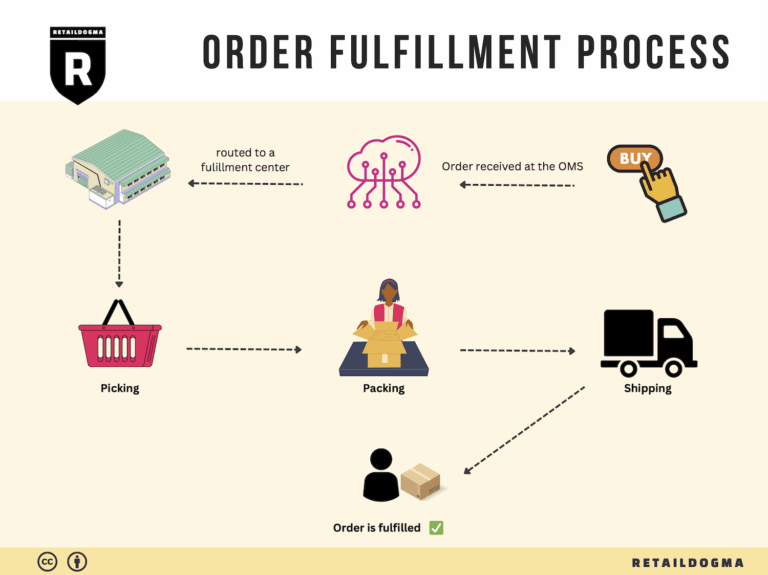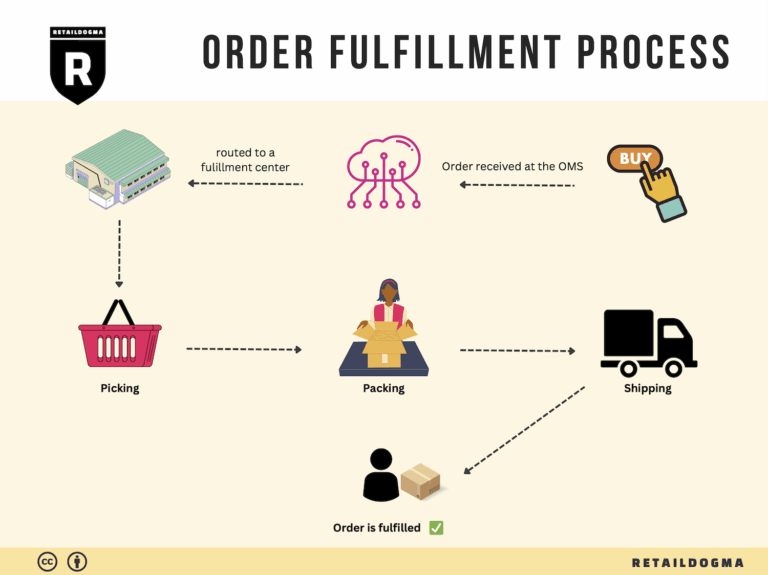What Is A Fulfillment Center? A Complete Guide (2025)
What is E-commerce Fulfillment? An Introduction for Growing Businesses
Understanding E-commerce Fulfillment: A Critical Component for Growing Businesses
As an e-commerce business owner, you may find yourself grappling with the overwhelming task of packing and shipping orders. While your focus is on scaling your sales and enhancing customer experience, the logistics of order fulfillment can become a significant bottleneck. This is where understanding e-commerce fulfillment becomes essential. At its core, fulfillment is the comprehensive process of getting a product into the hands of your customer, encompassing everything from order processing and inventory management to packaging and shipping.
In today’s competitive online marketplace, effective fulfillment is not just a backend operation—it’s a crucial part of your customer experience. It directly impacts your business’s efficiency, costs, and overall customer satisfaction. As you grow, the complexity of these processes increases, making it imperative to find a solution that allows you to scale without compromising quality or service.
This guide will delve into the various fulfillment models available, such as Third-Party Logistics (3PL) and Fulfillment by Amazon (FBA). Each model has its unique advantages and challenges, and understanding them is vital for making informed decisions that align with your business goals.
We will also explore the core services offered by fulfillment partners, including warehousing, inventory management, order processing, and returns management. These services can significantly alleviate the operational burden on your team, allowing you to focus on strategic growth initiatives.
Choosing the right fulfillment partner is a critical decision for any e-commerce business. This guide will provide insights into the key factors to consider—such as pricing structures, service level agreements, technology integrations, and customer support. We will also touch on how to evaluate potential partners to ensure they align with your operational needs and brand values.
Finally, we aim to demystify pricing in the fulfillment landscape. Understanding the cost implications of various services and models will empower you to make smart financial decisions that can enhance profitability.
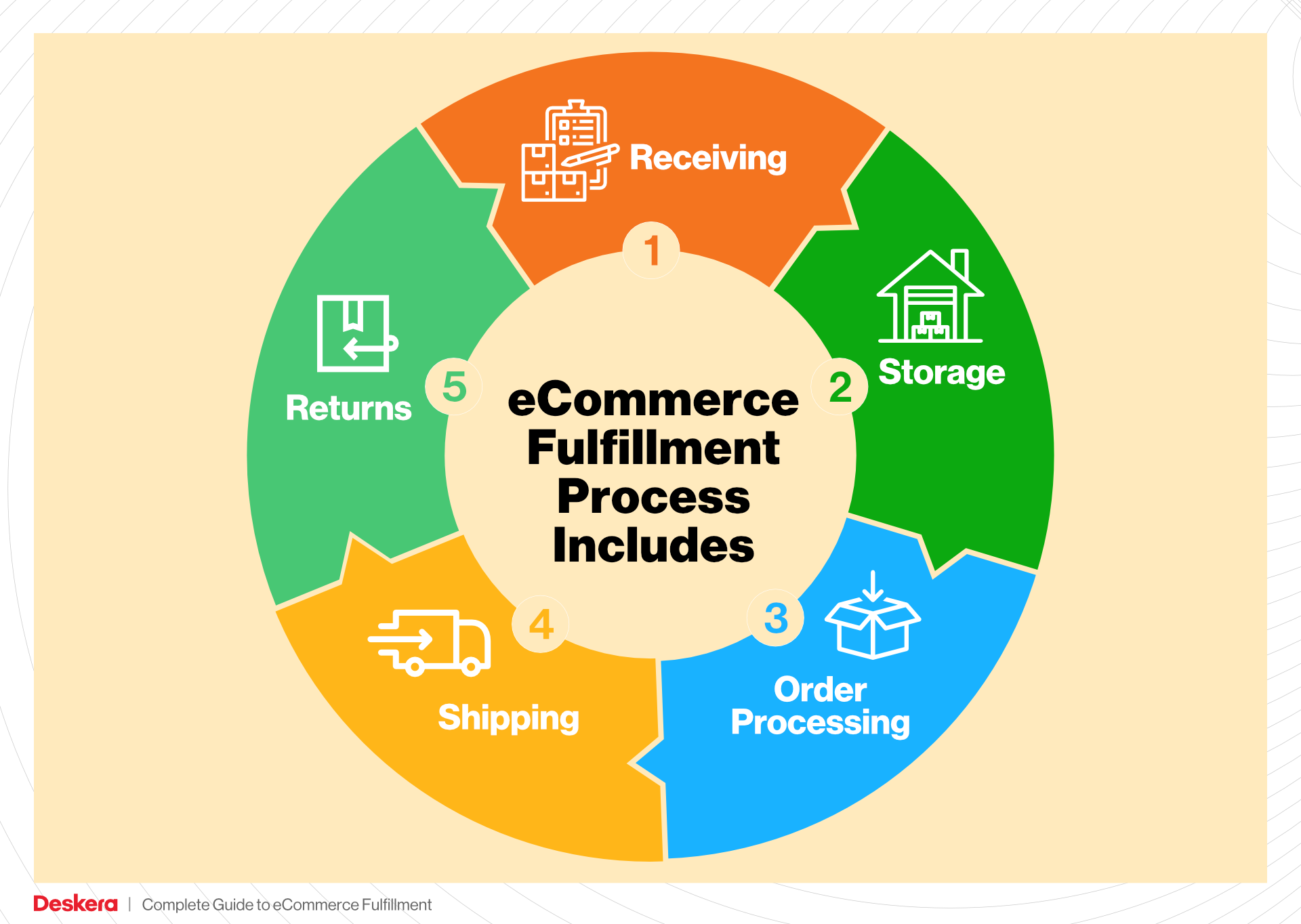
By the end of this guide, you will have a clearer understanding of e-commerce fulfillment and be better equipped to select a partner that can help you streamline your logistics, ultimately leading to a more efficient and customer-centric operation. Empower your business to thrive in the e-commerce space by making informed decisions about your fulfillment strategy.
What You’ll Learn In This Guide
- What is E-commerce Fulfillment? An Introduction for Growing Businesses
- The Order Fulfillment Process: From ‘Buy’ Button to Customer’s Door
- Comparing Fulfillment Models: In-House vs. 3PL vs. Dropshipping
- A Deep Dive into Amazon FBA: Pros, Cons, and Who It’s For
- Core Services Offered by Fulfillment Centers
- How to Choose a Fulfillment Partner: A 6-Point Checklist
- Understanding Fulfillment Pricing: A Breakdown of Common Fees
- Frequently Asked Questions (FAQs) about Fulfillment
- Conclusion: Is Outsourcing Fulfillment the Right Move for Your Business?
- Important Disclaimer
The Order Fulfillment Process: From ‘Buy’ Button to Customer’s Door
1. Receiving Inventory
The order fulfillment process begins with receiving inventory, a critical step that sets the foundation for efficient operations. When products arrive at the fulfillment center, they are checked against purchase orders to ensure accuracy. This involves verifying quantities, inspecting for damage, and confirming that the correct items have been delivered.
Importance: Efficient receiving processes prevent future complications in order fulfillment. Accurate inventory counts help avoid stockouts and overstock situations, which can lead to lost sales or increased holding costs.
Key Term: SKU (Stock Keeping Unit) – Each product is assigned a unique SKU, which simplifies tracking and inventory management. SKUs play a vital role in ensuring that the right items are accounted for and stored correctly.
2. Warehouse Storage
Once inventory is received and verified, it is stored in the warehouse. The layout of the warehouse is optimized for efficient storage and retrieval. Products are organized based on various factors, such as size, type, or sales velocity. This organization can include shelving units, bins, and pallets, allowing for easy access and efficient space utilization.
Importance: Effective warehouse storage minimizes the time required to locate products, which is crucial for maintaining fast order fulfillment times. A well-organized warehouse reduces the likelihood of errors and improves overall operational efficiency.
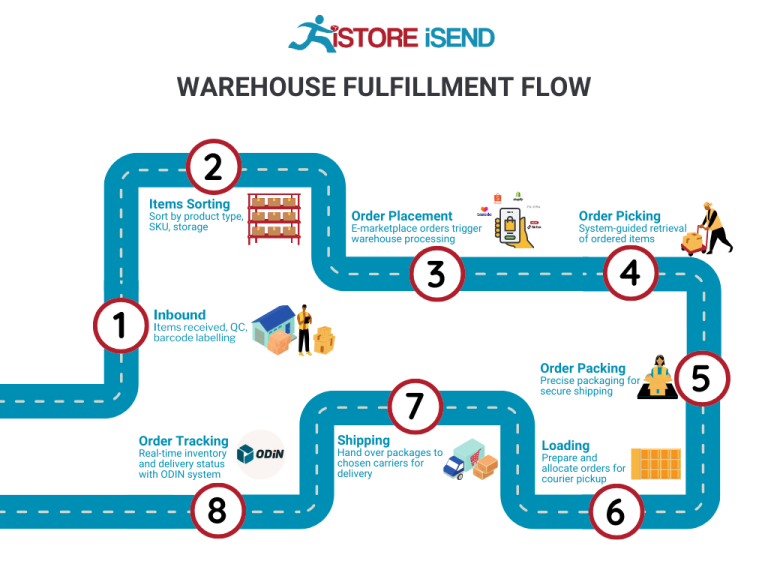
Key Term: FIFO (First In, First Out) – This inventory management method ensures that older stock is sold before newer stock, helping to prevent obsolescence and waste, especially for perishable goods.
3. Order Picking
Order picking is the process of selecting items from the warehouse to fulfill customer orders. Once an order is placed, a pick list is generated, detailing the items and their locations within the warehouse. Warehouse staff then use this list to gather the necessary products.
Importance: Accurate order picking is essential for customer satisfaction. Errors during this stage can lead to incorrect shipments, resulting in returns and dissatisfaction. Efficient picking processes, such as batch picking or zone picking, can greatly enhance speed and accuracy.
Key Term: Pick Lists – A document or digital tool that outlines the items needed for each order, including their locations in the warehouse. This aids in streamlining the picking process and ensuring order accuracy.
4. Order Packing
After items are picked, they move to the packing stage. During packing, products are carefully placed into boxes or envelopes, often with protective materials to prevent damage during shipping. This is also the stage where branding opportunities arise, as businesses can include custom packaging or promotional materials.
Importance: Proper packing not only protects products but also contributes to the unboxing experience, which can enhance customer satisfaction and brand loyalty. Efficient packing processes help reduce shipping costs and improve delivery speed.
Key Term: Kitting – This refers to the process of assembling multiple products into a single package or kit. Kitting can streamline fulfillment for subscription boxes or promotional offers, providing added value to customers.
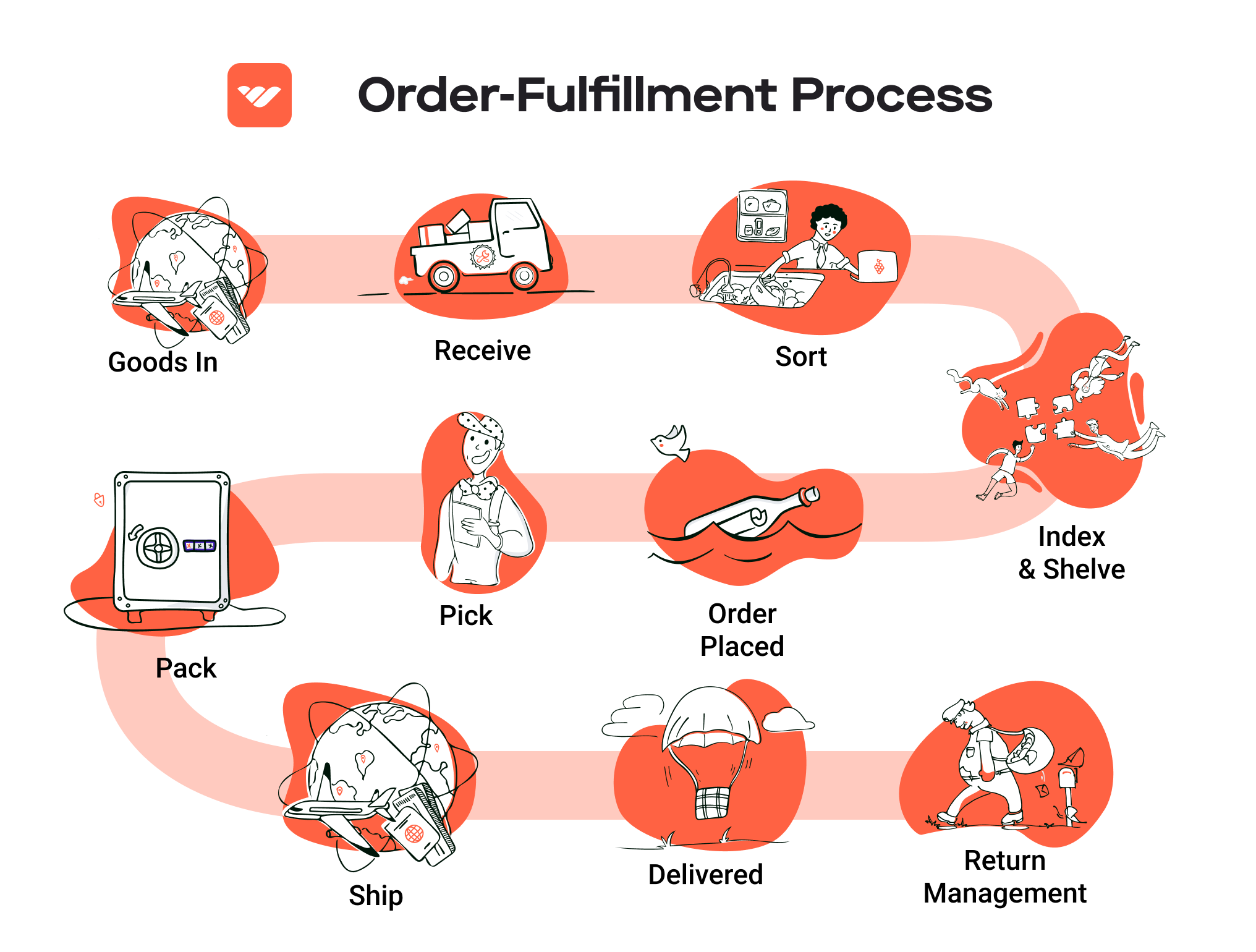
5. Shipping & Delivery
The final step in the order fulfillment process is shipping and delivery. Once orders are packed, they are labeled and handed over to shipping carriers. Businesses often collaborate with multiple carriers to offer customers various shipping options, including standard, expedited, and international shipping.
Importance: Timely delivery is crucial for customer satisfaction. Clear communication regarding tracking information and delivery expectations can enhance the customer experience and build trust.
Key Term: Shipping Network – This refers to the relationships and agreements a fulfillment partner has with various carriers (e.g., USPS, FedEx, UPS). A robust shipping network can help ensure reliable and cost-effective delivery options for customers.
In conclusion, understanding each step of the order fulfillment process—from receiving inventory to shipping and delivery—is vital for e-commerce businesses aiming to scale operations effectively. By optimizing these processes, businesses can enhance customer satisfaction, reduce costs, and ultimately drive growth.
Comparing Fulfillment Models: In-House vs. 3PL vs. Dropshipping
Fulfillment Models Overview
Understanding the various fulfillment models is critical for e-commerce businesses looking to scale efficiently. Each model presents its own unique set of advantages and challenges, making it essential to choose the right one based on your specific business needs and growth stage. Below is a comparative table of the three main fulfillment models: In-House Fulfillment, Third-Party Logistics (3PL), and Dropshipping.
| Model | Who Handles Inventory | Best For (Business Stage) | Key Advantage | Key Disadvantage |
|---|---|---|---|---|
| In-House Fulfillment | Your own team | Established businesses | Complete control over inventory and branding | High overhead costs and resource intensive |
| Third-Party Logistics (3PL) | External logistics provider | Startups to established | Scalability, expertise, and reduced shipping costs | Less control over inventory management |
| Dropshipping | Supplier or manufacturer | Startups and small businesses | Low startup costs and no inventory holding | Lower profit margins and dependency on suppliers |
In-House Fulfillment
In-house fulfillment refers to a model where the e-commerce business manages its own inventory and logistics operations. This model is often adopted by established businesses that have the resources to handle order processing, packing, and shipping internally.
Key Benefits: One of the primary advantages of in-house fulfillment is the complete control it offers over inventory management, shipping processes, and branding. Businesses can ensure that each package reflects their brand identity, from custom packaging to personalized notes, creating a memorable unboxing experience for customers. Additionally, having direct oversight of inventory levels allows for more precise management and quicker response times to changes in demand.
Key Challenges: However, this model is not without its drawbacks. The overhead costs can be significant, including warehousing, labor, and technology investments. Maintaining an in-house fulfillment operation requires a dedicated team, which can strain resources, especially for smaller businesses. Furthermore, as order volumes grow, scaling operations can become complex and costly.
Third-Party Logistics (3PL)
Third-party logistics (3PL) involves outsourcing fulfillment operations to an external provider that specializes in logistics and supply chain management. This model is suitable for businesses at various stages, from startups looking to streamline their operations to established companies seeking to optimize their logistics.
Key Benefits: One of the standout advantages of partnering with a 3PL provider is scalability. As your business grows, a 3PL can easily adjust to increased order volumes without the need for significant capital investment in infrastructure. Additionally, 3PLs often have established relationships with shipping carriers, which can lead to lower shipping costs and faster delivery times. Providers like eFulfillment Service, for instance, offer a range of services, including inventory management, pick and pack operations, and returns processing, allowing businesses to focus on core activities like marketing and product development.
Key Challenges: The primary disadvantage of using a 3PL is the reduced control over inventory management and logistics processes. Businesses must rely on the 3PL’s systems and practices, which can sometimes lead to miscommunication or discrepancies in inventory levels. Additionally, selecting the right 3PL partner is crucial; if the partnership doesn’t align with your business values or performance expectations, it can negatively impact customer satisfaction.
Dropshipping
Dropshipping is a fulfillment model where the retailer does not hold inventory but instead partners with suppliers who ship products directly to customers. This model is particularly appealing for startups and small businesses looking to minimize initial costs and risk.
Key Benefits: The most significant advantage of dropshipping is the low barrier to entry. Entrepreneurs can start an online store without the need for a significant upfront investment in inventory or warehousing. This model allows for a broader product selection, as businesses can offer a wide range of items without worrying about storage space or upfront costs. Additionally, since the supplier handles shipping, the retailer can focus on marketing and customer engagement.
Key Challenges: However, dropshipping comes with its own set of challenges. Profit margins can be lower compared to other fulfillment models, as suppliers often charge higher prices per unit. Additionally, the reliance on suppliers can lead to issues with product quality and shipping times, which can negatively affect customer satisfaction. As a retailer, you also have limited control over inventory levels, which can lead to situations where products are out of stock or delayed in shipping.
Conclusion
Selecting the right fulfillment model is crucial for the success of your e-commerce business. Each model—In-House Fulfillment, Third-Party Logistics, and Dropshipping—offers distinct advantages and challenges. Understanding these nuances will help you align your logistics strategy with your business goals, ensuring that you can scale efficiently while maintaining a high level of customer satisfaction. Assess your current stage, resources, and long-term vision to determine which model best fits your operational needs.
A Deep Dive into Amazon FBA: Pros, Cons, and Who It’s For
Understanding Fulfillment by Amazon (FBA)
Fulfillment by Amazon (FBA) is a service provided by Amazon that allows sellers to store their products in Amazon’s fulfillment centers. Amazon then takes care of storage, packaging, shipping, and customer service on behalf of the sellers. This model has become increasingly popular among e-commerce businesses looking to streamline their logistics and expand their reach.
How FBA Works
When a seller enrolls in the FBA program, they ship their products to Amazon’s fulfillment centers. Once the products are received, they are stored until sold. When a customer places an order for an FBA product, Amazon handles the entire fulfillment process, including picking, packing, and shipping the product directly to the customer. Additionally, FBA products are eligible for Amazon Prime, which can significantly enhance visibility and sales.
The seller has access to Amazon’s robust logistics network, including their advanced tracking system and customer service support. Sellers can also manage their inventory and track sales performance through the Amazon Seller Central platform.
Pros of Using FBA
-
Prime Eligibility: One of the most significant advantages of using FBA is that products become eligible for Amazon Prime. This means that customers can benefit from fast, free shipping, which can drive higher sales and increase customer loyalty.
-
Customer Trust: Amazon is a trusted brand with millions of customers. When a seller uses FBA, their products carry the Amazon logo, which can increase consumer trust and lead to higher conversion rates. Buyers often feel more secure purchasing from sellers using FBA due to the robust return and customer service policies that Amazon offers.
-
Multi-Channel Fulfillment: FBA is not limited to Amazon sales. Sellers can use FBA to fulfill orders from other sales channels, including their own websites or other e-commerce platforms. This multi-channel fulfillment capability allows sellers to centralize their logistics operations, reducing complexity.
-
Scalability: With FBA, sellers can easily scale their operations without worrying about warehousing, staffing, or logistics. As sales grow, Amazon can handle the increased volume, allowing sellers to focus on other aspects of their business, such as marketing and product development.
-
Inventory Management: Amazon provides tools for real-time inventory management, allowing sellers to monitor stock levels and make informed decisions. This can help avoid stockouts or overstock situations, which can be detrimental to sales.
Cons of Using FBA
-
High Fees: While FBA can provide significant benefits, it comes at a cost. Sellers must pay for storage fees, fulfillment fees, and additional costs for long-term storage if products do not sell quickly. These fees can eat into profit margins, especially for low-cost items.
-
Strict Inventory Rules: Amazon has stringent policies regarding inventory management. Sellers must ensure that their products comply with Amazon’s requirements, including packaging and labeling. Failure to adhere to these rules can result in penalties or even account suspension.
-
Commingling Risks: When using FBA, sellers’ inventory may be commingled with that of other sellers. This means that products from different sellers may be stored together, which can lead to issues if a customer receives the wrong item or if there are quality concerns. This risk is particularly significant for sellers with unique or branded products.
-
Loss of Control: By outsourcing fulfillment to Amazon, sellers lose some control over the customer experience. For example, the packaging may not reflect the seller’s brand, and sellers cannot personally manage customer service issues that arise.
-
Complex Return Process: While Amazon handles returns for FBA products, the process can be complex for sellers. Returns are processed through Amazon’s system, and sellers may have to deal with inventory discrepancies and account for returned items.
Who is FBA Best For?
Fulfillment by Amazon is best suited for e-commerce businesses that are looking to scale their operations quickly and efficiently without the overhead of managing logistics. It is particularly advantageous for:
-
Small to Medium-Sized Businesses: These businesses often lack the resources to manage their own fulfillment centers. FBA allows them to leverage Amazon’s infrastructure and expertise.
-
Product Categories with High Demand: Sellers with products that have consistent sales velocity can benefit from FBA’s fast shipping and storage capabilities, ensuring they can meet customer demand without delay.
-
Sellers Looking to Expand Reach: For businesses aiming to tap into the vast Amazon customer base and gain Prime eligibility, FBA provides a straightforward path to increased visibility and sales.
-
Multi-Channel Retailers: Businesses selling on multiple platforms can streamline their operations by utilizing FBA for all fulfillment needs, simplifying logistics and improving efficiency.
In conclusion, while FBA offers numerous advantages such as increased sales potential and operational efficiency, it is essential for sellers to consider the associated costs and risks. By understanding how FBA works and evaluating its pros and cons, e-commerce businesses can make informed decisions that align with their growth strategies.
Core Services Offered by Fulfillment Centers
Inventory Management & Warehousing
Inventory management and warehousing are foundational services provided by fulfillment centers that enable e-commerce businesses to efficiently store, track, and manage their products. A well-structured inventory management system allows businesses to maintain optimal stock levels, reducing the risk of overstocking or stockouts.
Fulfillment centers typically employ advanced software solutions that integrate seamlessly with e-commerce platforms. This integration allows real-time tracking of inventory levels, automatic alerts for low stock, and accurate forecasting based on historical sales data. As a result, businesses can make informed purchasing decisions, ensuring they always have the right products available to meet customer demand.
The benefits of effective inventory management and warehousing include:
- Cost Efficiency: By avoiding excess inventory, businesses can minimize storage costs and reduce capital tied up in unsold goods.
- Improved Customer Satisfaction: Reliable stock levels lead to better order fulfillment rates, ensuring customers receive their products on time.
- Scalability: As businesses grow, fulfillment centers can easily accommodate increased inventory needs without the hassle of managing additional storage space.
Pick and Pack Services
Pick and pack services are essential for streamlining the order fulfillment process. This service involves selecting items from the warehouse, packing them securely, and preparing them for shipment. Fulfillment centers employ trained staff and sophisticated systems to ensure high accuracy and efficiency in this process.
The benefits of utilizing pick and pack services include:
- Enhanced Order Accuracy: With specialized training and technology, fulfillment centers can achieve high accuracy rates, reducing the chances of shipping incorrect items.
- Speedy Processing: Experienced teams can process orders quickly, ensuring that products are shipped to customers in a timely manner.
- Branding Opportunities: Fulfillment centers can customize packing materials to reflect the brand’s identity, creating memorable unboxing experiences that enhance customer loyalty.
Kitting and Assembly
Kitting and assembly services involve combining multiple products into a single package or preparing items for sale in a specific configuration. This is particularly useful for businesses that offer bundles, gift sets, or subscription boxes. Fulfillment centers can manage the assembly process, ensuring that each kit meets quality standards before it is shipped.
The advantages of kitting and assembly services include:
- Simplified Logistics: By outsourcing kitting, businesses can streamline their logistics processes and reduce the complexities associated with managing multiple SKUs.
- Increased Sales Opportunities: Bundled offerings can attract more customers and encourage larger orders, boosting overall sales.
- Quality Control: Fulfillment centers can implement quality checks during the kitting process, ensuring that each kit meets the business’s specifications.
Returns Management (Reverse Logistics)
Returns management, also known as reverse logistics, is a critical service for e-commerce businesses. It involves handling the return of products from customers, processing these returns, and managing restocking or disposal as necessary. A well-organized returns management system can significantly enhance the overall customer experience and streamline operational efficiency.
The benefits of effective returns management include:
- Customer Retention: A hassle-free return process builds trust and encourages repeat purchases. Customers are more likely to shop with brands that make returns easy and straightforward.
- Inventory Control: Fulfillment centers can quickly inspect and restock returned items, ensuring that inventory levels are accurately maintained.
- Data Insights: Analyzing return data can provide valuable insights into product performance, customer preferences, and potential areas for improvement in product quality or marketing strategies.
Conclusion
By leveraging the core services offered by fulfillment centers—inventory management and warehousing, pick and pack services, kitting and assembly, and returns management—e-commerce businesses can enhance their operational efficiency, improve customer satisfaction, and scale effectively. Partnering with a reliable fulfillment center allows businesses to focus on their core competencies, such as product development and marketing, while leaving logistics and fulfillment in the hands of experts. As a result, e-commerce owners can confidently navigate the complexities of order fulfillment and position themselves for sustained growth in an increasingly competitive marketplace.
How to Choose a Fulfillment Partner: A 6-Point Checklist
Location & Warehouse Network
Choosing a fulfillment partner with strategically located warehouses is crucial for ensuring timely delivery and minimizing shipping costs. A well-distributed warehouse network allows for faster shipping to your target markets and can significantly enhance your customer satisfaction levels.
Questions to Ask:
– Where are your warehouses located, and how does that align with our primary customer base?
– What is your average shipping time to various regions?
– Do you have partnerships with local carriers to optimize shipping rates and delivery times?
Technology & Integrations
In the fast-paced e-commerce landscape, technology plays a pivotal role in streamlining operations. Your fulfillment partner should offer robust technology solutions that integrate seamlessly with your existing systems. This ensures real-time inventory management, order tracking, and easy communication between platforms.
Questions to Ask:
– What fulfillment management software do you use, and how does it integrate with our e-commerce platform?
– Can you provide real-time inventory updates and order tracking for both us and our customers?
– Do you support automated order processing, and how does your system handle inventory alerts?
Specializations (e.g., cold storage, oversized items)
Depending on your product offerings, it’s essential to choose a fulfillment partner with specific expertise that matches your needs. For instance, if you sell perishable goods, ensure they have proper cold storage facilities. Similarly, if you deal with oversized items, confirm they have the necessary equipment and space.
Questions to Ask:
– What types of products do you specialize in handling?
– Do you have the capabilities to manage temperature-sensitive products or oversized items?
– Can you accommodate unique packaging requirements for our products?
Scalability & Capacity
As your business grows, your fulfillment partner should be able to scale operations accordingly. A partner with limited capacity may hinder your growth, especially during peak seasons. Understanding their scalability options can save you from logistical nightmares later on.
Questions to Ask:
– What is your current fulfillment capacity, and how do you handle peak seasons?
– How quickly can you scale up operations in response to our growth?
– Are there any constraints on the number of SKUs or order volumes you can manage?
Pricing and Contracts
Transparent pricing structures and flexible contract terms are vital for maintaining a healthy cash flow while growing your business. Be wary of hidden fees, as these can quickly erode your profit margins. Understanding the financial aspects up front can prevent future complications.
Questions to Ask:
– Can you provide a detailed breakdown of your pricing model, including any potential hidden fees?
– What are your contract terms? Are there any long-term commitments required?
– Do you offer volume discounts or incentives for larger order fulfillment?
Customer Support & Reviews
Excellent customer support can make a significant difference in your fulfillment experience. A responsive and knowledgeable support team can help you resolve issues quickly, minimizing disruptions in your operations. Additionally, checking reviews and testimonials can provide insights into their reliability and service quality.
Questions to Ask:
– What type of customer support do you offer (e.g., phone, email, chat), and what are your response times?
– Can you provide references or case studies from businesses similar to ours?
– How do you handle fulfillment errors or customer complaints, and what is your process for resolution?
Conclusion
Choosing the right fulfillment partner is a critical decision that can significantly impact your e-commerce business’s success. By carefully considering these six key factors—location, technology, specializations, scalability, pricing, and customer support—you can ensure that you select a partner who not only meets your current needs but also supports your long-term growth objectives. Take the time to ask the right questions, do thorough research, and choose a partner that aligns with your business vision.
Understanding Fulfillment Pricing: A Breakdown of Common Fees
Initial Setup Fees
Initial setup fees are charges associated with getting your account established with a fulfillment center. These fees can cover a range of services, including account creation, system integration, and any necessary training or onboarding that may be required for your specific products and processes.
Typically, these fees can vary significantly between providers. Some fulfillment companies may offer free setup to attract new clients, while others might charge a one-time fee ranging from a few hundred to a few thousand dollars, depending on the complexity of your needs. When evaluating potential partners, always ask for clarity on what is included in the setup fee to avoid unexpected costs.
Receiving Fees
Receiving fees are incurred when your inventory arrives at the fulfillment center. This fee is charged for the labor and resources used to unload, inspect, and store your products.
Receiving fees are often calculated based on the volume of inventory being processed, typically charged per pallet or per item. For example, a fulfillment center might charge a flat rate for each pallet received, or they could charge a fee based on the number of items handled during the receiving process. It’s essential to understand how these fees are structured and to factor them into your overall cost assessment when choosing a fulfillment partner.
Storage Fees (per pallet/bin)
Storage fees refer to the costs associated with keeping your inventory at the fulfillment center. These fees can vary based on the type of storage (e.g., pallet vs. bin storage) and the duration for which your products are stored.
Most fulfillment companies charge storage fees on a monthly basis, calculated either per pallet or per cubic foot of space utilized. For instance, you might pay a monthly fee for each pallet your inventory occupies, or a rate based on the total volume of goods stored. It’s crucial to monitor your inventory turnover rate, as high storage fees can quickly accumulate if your products are not moving off the shelves efficiently.
Pick & Pack Fees (per item/order)
Pick and pack fees are charged for the labor involved in selecting products from the warehouse and preparing them for shipment. This process includes picking the items, packing them into boxes or bags, and labeling them for shipping.
These fees are usually calculated per item or per order. For example, a fulfillment center might charge a set fee for each item picked and packed, or a flat fee for each order processed, regardless of the number of items included. Understanding how these fees are structured is essential, especially if your business has varying order sizes. Efficiently managing your order volume and product selection can help minimize these costs.
Shipping Fees
Shipping fees encompass the costs incurred when sending products to customers. These fees depend on several factors, including the shipping method, the destination, the weight and dimensions of the package, and any additional services like insurance or expedited shipping.
Fulfillment centers typically charge shipping fees based on the carrier rates they have negotiated, which can vary widely. Some companies may offer discounted shipping rates, while others might pass on the full cost to you. It’s beneficial to discuss shipping options and potential savings with your fulfillment partner to find the best solution for your business needs.
Tips for Getting an Accurate Quote
-
Provide Detailed Information: When requesting a quote, supply as much detail as possible about your products, expected order volumes, and any specific services you require. This will help fulfillment companies provide a more accurate estimate.
-
Ask About Hidden Fees: Inquire about any additional costs that may not be included in the initial quote, such as return processing fees or charges for special handling.
-
Compare Multiple Providers: Don’t settle for the first quote you receive. Compare offers from several fulfillment companies to get a clearer picture of the market rates and services available.
-
Evaluate Flexibility: Look for providers that offer scalable solutions without long-term contracts. This flexibility can help you adjust your fulfillment strategy as your business grows.
-
Request a Breakdown of Costs: A detailed breakdown of all potential fees will help you understand the total cost of fulfillment and avoid surprises down the line.
By considering these common fees and following these tips, e-commerce business owners and entrepreneurs can make informed decisions about their fulfillment strategy, ensuring they partner with a provider that meets their needs while supporting their growth objectives.
Frequently Asked Questions (FAQs) about Fulfillment
1. What is a fulfillment center?
A fulfillment center is a specialized facility that manages the storage, packing, and shipping of products on behalf of e-commerce businesses. Unlike traditional warehouses, fulfillment centers focus on order processing and customer delivery, ensuring that products are quickly and efficiently dispatched to customers.
2. What’s the difference between a warehouse and a fulfillment center?
While both warehouses and fulfillment centers are used for storing goods, their functions differ significantly. A warehouse is primarily for storage, often housing inventory for extended periods. In contrast, a fulfillment center is designed for rapid order processing, including picking, packing, and shipping products directly to customers.
3. What is a 3PL?
A Third-Party Logistics provider (3PL) is a company that offers logistics services, including warehousing, fulfillment, and shipping, to other businesses. By outsourcing these operations to a 3PL, e-commerce companies can focus on their core activities, such as marketing and product development, while relying on the 3PL’s expertise in logistics.
4. How much do fulfillment services cost?
The cost of fulfillment services varies based on several factors, including the volume of orders, the size and weight of products, the complexity of services required (e.g., kitting, returns management), and the specific fulfillment provider. Typically, costs can include storage fees, pick-and-pack fees, shipping fees, and any additional services. It’s essential to request quotes from multiple providers to compare pricing.
5. How do I choose the right fulfillment partner?
When selecting a fulfillment partner, consider factors such as their experience in your industry, the technology they use (for inventory management and order tracking), customer service reputation, scalability, and pricing structure. Additionally, look for reviews and case studies from businesses similar to yours to gauge their effectiveness.
6. What services do fulfillment companies typically offer?
Fulfillment companies typically offer a range of services, including inventory storage, order processing, pick and pack, shipping, returns management, kitting, and integration with e-commerce platforms. Some may also provide additional services like custom packaging and branded unboxing experiences.
7. How long does it take for orders to be fulfilled?
Order fulfillment times can vary based on the fulfillment provider and the complexity of the order. Generally, most fulfillment centers process orders within 1-3 business days after receiving them. However, factors such as inventory availability, shipping method, and location can affect delivery times.
8. Can fulfillment services handle international shipping?
Yes, many fulfillment companies offer international shipping services. They typically have established relationships with various carriers and can navigate the complexities of international shipping regulations, customs duties, and taxes. It’s crucial to confirm this capability when selecting a fulfillment partner if you plan to expand your market globally.
9. What technology do fulfillment companies use?
Fulfillment companies often utilize advanced technology systems, including warehouse management systems (WMS), inventory management software, and shipping software. These technologies help streamline operations, provide real-time inventory tracking, and enable seamless integration with e-commerce platforms, allowing businesses to monitor orders and stock levels efficiently.
10. How can I optimize my fulfillment process?
To optimize your fulfillment process, consider the following strategies: choose a fulfillment partner that aligns with your business needs, regularly review inventory levels to avoid stockouts, implement automation where possible, and analyze shipping options for cost efficiency. Additionally, maintaining clear communication with your fulfillment provider can help address any challenges promptly.
Conclusion: Is Outsourcing Fulfillment the Right Move for Your Business?
Evaluating the Benefits of Outsourcing Fulfillment
Outsourcing fulfillment can be a game-changer for e-commerce businesses looking to scale efficiently. One of the most significant advantages is the time savings it offers. By partnering with a fulfillment service, you can offload the complexities of inventory management, order processing, and shipping logistics. This allows you to focus your energy on core business activities such as product development, marketing, and customer engagement—areas that directly contribute to growth.
Scalability is another crucial benefit. As your sales volume fluctuates, a reliable fulfillment partner can adapt to your needs without the burden of hiring additional staff or investing in infrastructure. Whether you experience seasonal spikes or steady growth, a third-party logistics provider (3PL) can seamlessly adjust to your requirements, ensuring that you maintain high service levels without compromising your resources.
Moreover, leveraging the expertise of a fulfillment service can enhance your operational efficiency. Established providers bring years of experience and industry knowledge to the table, ensuring that your logistics processes are optimized. This includes everything from sophisticated inventory management systems to streamlined return processes, allowing you to deliver an exceptional customer experience.
However, the success of outsourcing fulfillment largely depends on choosing the right partner. It’s essential to align with a 3PL that understands your business model, values customer service, and can scale alongside you.
Next Steps: Audit Your Current Shipping Process
To determine if outsourcing fulfillment is the right move for your business, consider conducting a thorough audit of your current shipping processes. Evaluate your operational bottlenecks, costs, and customer satisfaction levels. This insight will guide you in making an informed decision about whether a fulfillment partner could enhance your efficiency and support your growth ambitions. Take the first step toward a more streamlined and effective logistics strategy today.
Important Disclaimer
⚠️ Important Disclaimer
The information in this guide is for educational purposes. Fulfillment services, pricing, and platform features change frequently. Always conduct your own due diligence and consult with providers directly before making business decisions.
